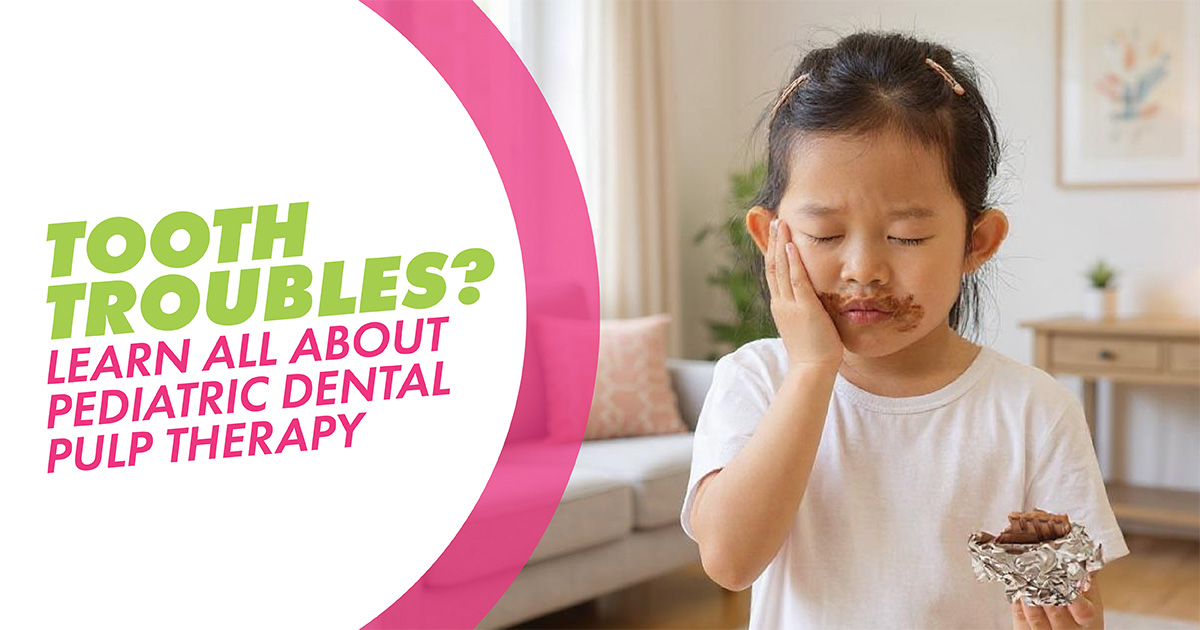
As a parent, hearing that your child might need a root canal or pulp therapy can be pretty alarming. But don’t worry! Pediatric pulp therapy is a safe and effective treatment designed to save your child’s tooth when it has been damaged by decay or trauma.
In this blog, our Naperville pediatric dentists will explain exactly what pulp therapy is, when it’s necessary and how it works to keep your little one’s smile healthy.
What Is Dental Pulp?
Before we get into the treatment itself, let’s break down what dental pulp is. The pulp is the soft tissue inside the center of each tooth. It contains blood vessels, nerves and connective tissue that keep the tooth alive by delivering oxygen and nutrients.
Normally, the pulp is protected by the outer layers of the tooth, called enamel and dentin. But when a tooth gets badly decayed or injured, the pulp can become exposed or infected, leading to pain and other issues.
What Is Pediatric Pulp Therapy?
When your child’s tooth pulp is damaged, the goal is to save the tooth and prevent further complications. That’s where pediatric pulp therapy comes in. It’s a procedure used to treat the damage inside the tooth and preserve it, so it doesn’t have to be pulled out too soon.
In some cases, the pulp becomes infected or inflamed due to severe decay or an injury. If this happens, your child might need pulp therapy procedures like a pulpotomy or dental pulpectomy.
Why Is Pediatric Pulp Therapy Important for Baby Teeth?
You might be wondering why it’s necessary to get a root canal on a baby tooth when it’s going to fall out eventually. The truth is, baby teeth are incredibly important for your child’s oral and facial development. They:
- Save space for the permanent teeth to erupt
- Guide permanent teeth into place
- Promote speech development
- Help kids chew properly
- Support proper jaw and facial growth
Losing baby teeth too early due to infection or trauma can cause problems, including misalignment of the permanent teeth.
Pulp therapy helps preserve these important teeth to ensure your child’s smile stays healthy and their adult teeth come in properly.
When Is Pulp Therapy Necessary?
When is pulp therapy actually needed? The most common reasons for needing pulp therapy are:
- Pulp exposure from untreated cavities or tooth decay
- Trauma to the tooth, like a fall or impact during sports
- Pulpitis, or inflammation of the pulp due to infection
- Pulp necrosis, which is when the pulp tissue dies. Pulp necrosis symptoms can include pain and sensitivity; however, as the condition progresses and the nerve dies, the pain and sensitivity may disappear. That doesn’t mean the tooth is cured. Treatment is still necessary to treat the infection and stop it from spreading.
If your child is experiencing pain in a specific tooth, sensitivity to hot or cold foods, or has visible tooth discoloration (for example, a baby’s teeth turning black), it could be a sign that the pulp is in trouble and needs attention.
Pulpotomy vs. Root Canal: What’s the Difference?
When your pediatric dentist recommends pulp therapy, they’ll determine whether a pulpotomy procedure or a dental pulpectomy (root canal) is needed. Here’s the difference:
- Pulpotomy Procedure: This is usually the first step when the pulp damage is contained in the crown of the tooth (the part you see). In a vital pulpotomy, the dentist removes the infected part of the pulp but leaves the healthy tissue untouched. They fill the space with a special material to protect the tooth. A crown might be placed on top to keep the tooth strong and prevent future damage.
- Dental Pulpectomy (Root Canal): If the infection has spread to the root of the tooth, a dental pulpectomy may be necessary. This is essentially a root canal procedure where the dentist removes all of the pulp, cleans out the root canals and fills the space with a biocompatible material to preserve the tooth. This is more common for permanent teeth, but can sometimes be done on baby teeth if they’re too damaged to preserve otherwise.
What About the Pulp Capping Procedure?
In cases where the pulp is exposed but not infected, a pulp capping procedure might be an option. This involves placing a protective layer over the exposed pulp to help it heal. It’s less invasive than a full pulpotomy or pulpectomy, but it’s only suitable for less severe cases.
How Is Pediatric Pulp Therapy Performed?
The procedure itself is pretty straightforward, and your child will be in good hands. Here’s what to expect during pediatric pulp therapy:
- The dentist will numb the affected area with local anesthesia to make sure your child doesn’t feel any pain during the procedure.
- We’ll isolate the area we’re treating with Dry Shield, a more comfy, child-sized alternative to rubber dental dams.
- For the pulpotomy procedure, the dentist will remove the infected pulp from the crown, clean the empty space and fill it with a protective material. If a dental pulpectomy is needed, the dentist will remove all the pulp, clean the root canals and fill them with a biocompatible material.
- A dental crown or filling will be placed on the tooth to protect it from future damage.
If your child is very young, anxious or has special healthcare needs that make it difficult to safely receive dental care, sedation dentistry is an option. At Innovative Pediatric Dentistry, we offer laughing gas (nitrous oxide) and general anesthesia. Your Naperville pediatric dentist will clearly explain your options and help you make the best choice for your child.
Is Pediatric Pulp Therapy Safe?
Yes, pediatric pulp therapy is very safe! Pediatric dentists are trained to handle these procedures with the utmost care. Our kid-friendly dental practice uses the latest technology and techniques for faster, more comfortable, more precise treatment. We also use local anesthetics and offer sedation options to keep your child comfortable during the procedure. The goal is always to save the tooth and prevent the need for extraction.
Signs Your Child Might Need Pulp Therapy
Signs your child needs pulp therapy include:
- Pain in the affected tooth, especially at night or when eating
- Sensitivity to hot or cold foods
- Swelling or redness around the tooth or gums
- Visible discoloration, like a child’s or baby’s tooth turning black or gray
- Tooth mobility (the tooth feels loose)
If your child is experiencing any of these symptoms, it’s important to get them checked out by a pediatric dentist to prevent further complications.
The Bottom Line
Pediatric pulp therapy is an essential treatment that can save your child’s tooth when it has been damaged by decay or injury. Whether through a pulpotomy or a dental pulpectomy, these procedures help to eliminate pain and infection, preserve baby teeth and keep your child’s orofacial development on track.
Expert Pediatric Pulp Therapy in Naperville, IL
If you notice any signs of pulp damage or your child is experiencing tooth pain, schedule an appointment at Innovative Pediatric Dentistry today!
An experienced Naperville pediatric dentist will perform an exam and determine if pulp therapy is necessary to preserve your child’s tooth. If it is needed, our team will ensure your child is comfortable and relaxed throughout the procedure.

